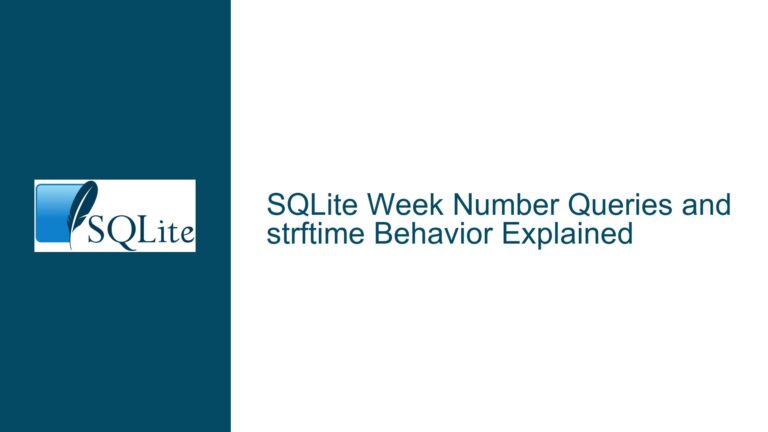Implementing a Custom String Splitting Function in SQLite for Multi-Value Data Extraction
Extracting Delimited Substrings in SQLite: The Need for a GetPart Function
SQLite, while powerful and versatile, lacks a built-in function to directly extract the Nth part of a delimited string. This functionality is often required in scenarios where data is stored in a denormalized format, such as comma-separated values within a single column. The absence of such a function forces developers to resort to complex combinations of instr and substr functions, which can quickly become unwieldy and difficult to maintain. The proposed GetPart function aims to simplify this process by providing a straightforward way to extract specific segments from a delimited string, either from the left or the right, and even return all segments as a virtual table when needed.
The GetPart function would accept three parameters: the input string, the delimiter, and the index of the segment to extract. A positive index would count segments from the left, while a negative index would count from the right. An index of zero could be used to return all segments as a virtual table, mimicking the behavior of a SELECT statement with UNION ALL. This functionality would be particularly useful in scenarios where normalizing the data into multiple tables is impractical or where space efficiency is a priority.
Challenges with Nested instr and substr Combinations
The primary challenge with using nested instr and substr functions to achieve the same result as the proposed GetPart function is the complexity and verbosity of the resulting SQL code. For example, extracting the second segment from a comma-separated string would require multiple nested function calls, making the query difficult to read and maintain. Additionally, this approach is prone to errors, especially when dealing with edge cases such as empty strings, missing delimiters, or out-of-range indices.
Moreover, the lack of a built-in function for this purpose can lead to inconsistent implementations across different queries or even different developers working on the same project. This inconsistency can result in subtle bugs and make the codebase harder to understand and debug. The GetPart function would provide a standardized way to handle these scenarios, reducing the likelihood of errors and improving code readability.
Implementing GetPart: Custom SQLite Functions and Virtual Tables
To implement the GetPart function in SQLite, developers can leverage SQLite’s support for custom functions and virtual tables. Custom functions can be created using the sqlite3_create_function API, allowing developers to extend SQLite’s built-in functionality with their own C or C++ code. This approach would enable the creation of a GetPart function that behaves exactly as described, with support for positive and negative indices and the ability to return all segments as a virtual table.
For the virtual table functionality, SQLite’s sqlite3_module API can be used to create a custom virtual table that splits the input string into segments and returns them as rows. This would allow the GetPart function to be used in contexts where a SELECT statement is expected, providing even greater flexibility and power. By combining these two approaches, developers can create a robust and versatile solution for handling multi-value data in SQLite.
Example Implementation in C
Below is an example of how the GetPart function could be implemented in C using SQLite’s API:
#include <sqlite3.h>
#include <stdio.h>
#include <string.h>
void getPartFunc(sqlite3_context *context, int argc, sqlite3_value **argv) {
const char *input = (const char *)sqlite3_value_text(argv[0]);
const char *delimiter = (const char *)sqlite3_value_text(argv[1]);
int index = sqlite3_value_int(argv[2]);
if (input == NULL || delimiter == NULL) {
sqlite3_result_null(context);
return;
}
char *inputCopy = strdup(input);
char *token = strtok(inputCopy, delimiter);
int currentIndex = 1;
while (token != NULL) {
if (index > 0 && currentIndex == index) {
sqlite3_result_text(context, token, -1, SQLITE_TRANSIENT);
free(inputCopy);
return;
} else if (index < 0 && currentIndex == (strlen(input) - index)) {
sqlite3_result_text(context, token, -1, SQLITE_TRANSIENT);
free(inputCopy);
return;
}
token = strtok(NULL, delimiter);
currentIndex++;
}
free(inputCopy);
sqlite3_result_null(context);
}
int sqlite3_extension_init(sqlite3 *db, char **pzErrMsg, const sqlite3_api_routines *pApi) {
SQLITE_EXTENSION_INIT2(pApi);
sqlite3_create_function(db, "GetPart", 3, SQLITE_UTF8, NULL, getPartFunc, NULL, NULL);
return SQLITE_OK;
}
This implementation defines a getPartFunc function that takes three arguments: the input string, the delimiter, and the index. It uses the strtok function to split the input string into tokens and iterates through them until it finds the desired segment. If the segment is found, it is returned as the result; otherwise, NULL is returned.
Using the GetPart Function in SQL Queries
Once the GetPart function is implemented and registered with SQLite, it can be used in SQL queries just like any other built-in function. For example:
SELECT GetPart('John,Mary,Tom', ',', 2); -- Returns 'Mary'
SELECT GetPart('2021-01-14', '-', -1); -- Returns '14'
SELECT GetPart('John,Mary,Tom', ',', 0); -- Returns a virtual table with 'John', 'Mary', and 'Tom'
The third query demonstrates the virtual table functionality, where the GetPart function returns all segments as rows. This can be particularly useful in scenarios where the delimited string needs to be treated as a set of values, such as in a JOIN or WHERE clause.
Performance Considerations
While the GetPart function provides a convenient way to extract delimited substrings, it is important to consider its performance implications, especially when dealing with large datasets or complex queries. The function’s performance will depend on the efficiency of the string splitting algorithm and the size of the input strings. In cases where performance is critical, it may be necessary to optimize the implementation or consider alternative approaches, such as pre-processing the data to split the delimited strings into separate columns or tables.
Conclusion
The proposed GetPart function addresses a common need in SQLite by providing a simple and efficient way to extract delimited substrings from a string. By leveraging SQLite’s support for custom functions and virtual tables, developers can implement this functionality in a way that is both powerful and flexible. While the function can be implemented using existing SQLite functions, a custom implementation offers significant advantages in terms of code clarity, maintainability, and performance. As with any database optimization, it is important to carefully consider the specific requirements and constraints of the application to determine the best approach.






